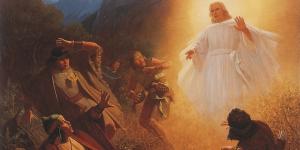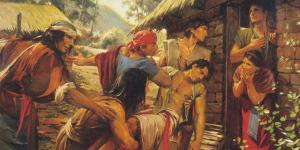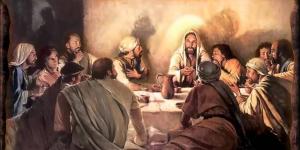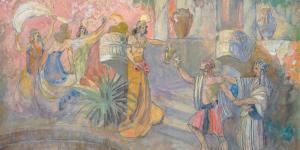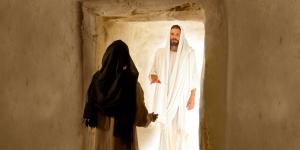You are here
Book of Mormon Central is in the process of migrating to our new Scripture Central website.
We ask for your patience during this transition. Over the coming weeks, all pages of bookofmormoncentral.org will be redirected to their corresponding page on scripturecentral.org, resulting in minimal disruption.

Scripture Block
Alma 36-39
To teach class members Alma’s counsel for remaining faithful in the gospel and to help parents understand how to teach and counsel both righteous and unrighteous children.
Lesson Manual
Multimedia
Video: BYUtv Discussions on the Book of Mormon: Alma 36-37. Available at BYUtv.org
Video: BYUtv Discussions on the Book of Mormon: Alma 38-39. Available at BYUtv.org
Video: Interpreter Scripture Roundtable: Book of Mormon Gospel Doctrine 29
Chart 36: "Nephihah as Chief Judge: Years 9-24 of the Reign of the Judges" from Charting the Book of Mormon.
Chart 54: "Key Doctrinal Chapters: Mosiah-Alma" from Charting the Book of Mormon.
Chart 60: "The Speeches of Alma" from Charting the Book of Mormon.
Chart 106: "Three Accounts of Alma's Conversion" from Charting the Book of Mormon.
Chart 107: "Shared Words in the Three Accounts of Alma's Conversion" from Charting the Book of Mormon.
Chart 132: "Chiasmus in Alma 36" from Charting the Book of Mormon.
Chart 145: "Nephite Cycles: Years 1-49 of the Reign of the Judges" from Charting the Book of Mormon.
Articles
Alma 36
"Helaman," Book of Mormon Onomasticon.
An etymology of the name "Helaman," the son of Alma.
"Helaman, the son of Alma," The Dictionary of the Book of Mormon, George Reynolds, ed. (Salt Lake City, UT: J. H. Parry, 1891). Available at wikisource.org and archive.org
Though dated, this nineteenth century dictionary provides a biographical entry on Helaman, based on what is told about him in scripture.
John W. Welch, "Chiasmus in Alma 36," FARMS Preliminary Report (1989).
In a preliminary analysis, Welch details the poetry found in Alma 36. This powerful chapter tells the story of Alma's conversion in one extended poem known in Hebrew literature as chiasmus. The more full treatment of the chiasm is found in Rediscovering the Book of Mormon.
John W. Welch, "A Masterpiece: Alma 36," in Rediscovering the Book of Mormon.
Alma 36 has long been heralded as an example of an extended chiasm. John Welch lays out his detailed analysis of the chiasm and explains how the entire chapter functions as a beautiful, poetic whole.
S. Kent Brown, "Alma's Conversion: Reminiscences in His Sermons," in A Book of Mormon Treasure: Gospel Insights from General Authorities and Religious Educators.
Alma uses his conversion experience as a persuasive teaching tool. The three-day period during which he received a visit from an angel and underwent a remarkable change enabled him later to speak from experience as he preached repentance and the cleansing power of the word of God. Not only did he illumine the dark, awful state in which persons find themselves if they do not repent, but he could especially beam light on the indescribable joy that accompanies forgiveness of sin. At base, he sought earnestly that others be born of God as he had been.
John A. Tvedtnes, "The Voice of an Angel," in Book of Mormon Authorship Revisited.
Tvedtnes explores the incidents where angels show up in the Book of Mormon text, particularly in reference to Alma's conversion story. In Alma 36, Alma speaks to his son Helaman about his experience with the angel of God, which spoke with a voice of thunder.
B. H. Roberts, "A Nephite's Commandments to His Three Sons - I. Helaman," Improvement Era 3, no. 8 (1900).
In a turn-of-the-century perspective on this chapter, B. H. Roberts gives an overview of Alma's addresses to his sons. In this chapter he focuses on Alma's son Helaman. As one of Alma's righteous sons, Helaman gets to be recipient to Alma's powerful conversion story.
Earl M. Wunderli, "Critique of Alma 36 as an Extended Chiasm," Dialogue: A Journal of Mormon Thought 38, no. 4 (2005): 97-110.
Wunderli challenges the traditionally accepted explanation of Alma 36 as an extended chiasmus. Wunderli argues this on the basis of asymmetry in one portion of the chiasm, and he argues that Welch ignores much of the chapter that does not fit into a chiastic structure.
Boyd F. Edwards, and W. F. Edwards, "Response to Earl Wunderli's Critique of Alma 36 as an Extended Chiasm," Dialogue: A Journal of Mormon Thought 39, no. 3 (2006).
In a dialog between two camps, this article responds to the one above by providing a defense for Alma 36 as a chiasm and critiques Wunderli's argument in his article from 2005.
Earl M. Wunderli, "Response to Boyd and Farrell Edwards's Response to My 'Critique of Alma 36 as an Extended Chiasm,'" Dialogue: A Journal of Mormon Thought 39, no. 3 (2006).
In the same journal issue, Wunderli defends his position against the critique of Edwards and Edwards.
Daniel C. Peterson, "Book of Mormon Alma 36," Blog post on Patheos (June 25, 2016).
In a blog post, Dan Peterson provides his own insight into Alma 36, as well as provides additional resources for further study of this complex literary masterpiece.
Boyd F. Edwards and W. Farrell Edwards, "Does Chiasmus Appear in the Book of Mormon by Chance?" BYU Studies Quarterly 43, no. 2 (2004): 103-130.
In 1969, John W. Welch reported his discovery of many-element chiasms in the Book of Mormon, which Joseph Smith testified to have translated from plates written anciently by Hebrew descendants. Chiasmus is an inverted-parallel literary form that was employed by ancient Hebrew biblical writers, among others. An instance of this form, called a “chiasm,” presents two or more literary elements, and then restates them in reverse order. Short chiasms are not uncommon in literature. In some cases, the authors undoubtedly intended to use that form for literary effect (that is, by design); in other cases, the elements fell into that form without author intent (that is, by chance).
Boyd F. Edwards and W. Farrell Edwards, "When Are Chiasms Admissible as Evidence?" BYU Studies Quarterly 49, no. 4 (2010): 131-154.
Since John Welch's discovery of chiasmus in the Book of Mormon in 1967, many critics have attempted to show how chiasmus appears in just about every type of literature, from Dr. Seuss to Strangite scripture. This article discusses the authors' statistical admissibility tests to verify whether a chiasmus in a work shows strong evidence of intentionality by the original author. Their results indicate that certain passages in the Old Testament and in the Book of Mormon show deliberate chiasmus, while Strangite scripture, the Doctrine and Covenants, nursery rhymes, Dr. Seuss, and other works are not intentionally chiastic.
Alma 37
"Gazelem," Book of Mormon Onomasticon.
An etymology of the word "Gazelem," as mention in Alma 37:23.
John A. Tvedtnes, "My Servant Gazelem," on bookofmormonresearch.org. This article was written and approved as a FARMS Update in 2005, but never published.
The word Gazelem appears in Alma 37 in reference to seers and oracles. It is unclear if this word is refering to a person or to a seer stone. Tvedtnes explains this word's appearance in reference to Joseph Smith, the seer and prophet of the Restoration.
Richard E. Turley, Jr., Robert S. Jensen, and Mark Ashurst-McGee, "Joseph the Seer," Ensign (October 2015).
The Church history department provides a thoughtful look at the nature of seers and the mission of Joseph Smith. In the article, they discuss the occurrence of Gazelem in Alma and uses it to explain ancient and modern instruments used to channel the power of God.
Matthew Roper, "Teraphim and the Urim and Thummim," Insights 20, no. 9 (2000).
Matthew Roper discusses the peculiar use of teraphim in the Bible and their relation to the Urim and Thummim. He mentions Gazelem as an instance of using oracular devices other than the Urim and Thummim for prophecy.
Roger Nicholson, "The Spectacles, the Stone, the Hat, and the Book: A Twenty-first Century Believer’s View of the Book of Mormon Translation," Interpreter: A Journal of Mormon Scripture 5 (2013): 121-190.
Since Alma 37 discusses the role of seers and prophecy, this article helps readers understand the Book of Mormon translation process and how Joseph Smith used various tools to fill his role as a seer. This essay also seeks to examine the Book of Mormon translation method from the perspective of a regular, nonscholarly, believing member in the twenty-first century, by taking into account both what is learned in Church and what can be learned from historical records that are now easily available. This essay focuses primarily on the methods and instruments used in the translation process and how a faithful Latter-day Saint might view these as further evidence of truthfulness of the restored Gospel.
Alma 38
"Shiblon," Book of Mormon Onomasticon.
An etymology of the name "Shiblon," the son of Alma.
"Shiblon, the son of Alma," A Dictionary of the Book of Mormon, George Reynolds, ed. (Salt Lake City, UT: J. H. Parry, 1891). Available at archive.org
Though dated, this nineteenth century dictionary provides a biographical entry on Shiblon, based on what is told about him in scripture.
Gordan C. Thomasson and John W. Welch, "The Sons of the Passover," in Reexploring the Book of Mormon: A Decade of New Research (Provo, UT: FARMS, 1992).
This article explores the ancient Jewish tradition at Passover that seems to find resonance in Alma's discourses to his various sons. At Passover, there is a tradition that the sons would ask the father separate questions to which the father would respond. These questions find somewhat of a correspondence with the questions asked by Alma's sons in Alma 35-39.
Van Dyke, Blair G.. "Light or Dark, Freedom or Bondage: Enhancing Book of Mormon Themes through Contrasts," Religious Educator: Perspectives on the Restored Gospel 6, no. 3 (2005): 99-116.
This article will show how a study of contrasts can help enhance our understanding of major themes in the Book of Mormon, thereby enabling us to identify, analyze, apply, and present guiding principles couched in the scriptures. Several points in the Book of Mormon contrast light and dark, including the story of Alma the Younger. The petulant Alma in the beginning of Mosiah 27 is contrasted with the sobered and enlightened Alma at the end. While Alma was once a rebellious son of the king, after his dramatic conversion, he becomes a force for good by reigning as the chief judge over the people of Nephi.
Bruce C. and Marie K. Hafen, "Bridle All Your Passions," Ensign (February 1994).
This devotional article from the ensign takes the teaching to "bridle all your passions" in Alma 38 and applies it to relationships today. Exhibiting self-control and discipline in our behavior around the one we love while dating will help us foster joy and fidelity in marriage.
Alma 39
"Corianton," Book of Mormon Onomasticon.
An etymology of the name "Corianton," the son of Alma.
"Corianton," A Dictionary of the Book of Mormon, George Reynolds, ed. (Salt Lake City, UT: J. H. Parry, 1891). Available at wikisource.org and archive.org
Though dated, this nineteenth century dictionary provides a biographical entry on Corianton, based on what is told about him in scripture.
Ball, Terry B. "Alma 39: A Model for Teaching Morality," Religious Educator: Perspectives on the Restored Gospel 2, no. 2 (2001): 25-36.
Alma 39 provides counsel on eschewing sexual immorality. In a pedagogical approach, Terry Ball analyzes not only the “what” but also the “how” of Alma’s counsel in order to help identify important principles and methodology for effective teaching of this difficult subject. This analytical approach can be an engaging way to teach Alma 39 to students and help them internalize and find application for the chapter’s message.
Jeffrey R. Holland, "Of Souls, Symbols, and Sacraments," BYU Devotional (January 12, 1988).
In a devotional address at BYU, Elder Jeffrey R. Holland discourses on the sacred nature of human intimacy and stresses the importance of chastity. He uses Alma 39 to teach principles of morality and sexual purity.
Hilton, III, John, "Textual Similarities in the Words of Abinadi and Alma's Counsel to Corianton," BYU Studies 51, no. 2 (2012): 39-60.
John Hilton examines textual similarities between two texts found in the Book of Mormon: the words of Abinadi in Mosiah 12–17 and the words of Alma the Younger in Alma 39–42. Hilton used both human-based and computer-based techniques to search for textual matches.
John Gee, "Scripture Insight: Book of Mormon Word Usage: To Cross Oneself," Insights 21, no. 6 (2001).
In Alma 39, Alma tells Corianton to cross himself. This peculiar phrase is explained John Gee as a synonym for "to contradict", something consistent with the vocabulary of Joseph Smith's day.
John A. Tvedtnes, John Gee, Matthew Roper, "Book of Mormon Names Attested in Ancient Hebrew Inscriptions," Journal of Book of Mormon Studies 9, no. 1 (2000): 40-51, 78-79.
Alma 39:3, we learn that Corainton followed after the harlot Isabel. This name is attested in ancient Hebrew inscriptions, as discussed by Tvedtnes, Gee, and Roper.
Michael R. Ash, “The Sin ‘Next to Murder’: An Alternative Interpretation,” Sunstone, November 2006, 34–43.
When Alma condemns Corianton for committing a sin next to murder, many assume he is referring to Corianton's sexual transgressions. However, Ash proposes that it is a broad simplification to classify sexual transgression as a sin next to murder. He proposes that Alma is referring to many of Corianton's sins, such as abandoning the ministry and specifically doing damage to others' testimonies.
B. W. Jorgensen, “Scriptural Chastity Lessons: Joseph and Potiphar’s Wife; Corianton and the Harlot Isabel,” Dialogue: A Journal of Mormon Thought 32, no. 1 (1999): 7–34.
Jorgensen also disagrees with the common interpretation that Corianton's great sin was sexual immorality. He argues that there is much more at work in Corianton's story that readers should note. He has not, so far, described the young man as a fornicator,
but only as a brash and rash youth who overreached himself, transgressed some borders, for "vain and foolish" reasons he probably hid from himself under a varnish of highminded self-esteem.
Additional Lesson Guides
RSC Gospel Doctrine Lesson #29
LDS Living Gospel Doctrine Lesson #29
Meridian Magazine Gospel Doctrine Lesson #28
GospelDoctrine.com Alma 36, Alma 37, Alma 38, Alma 39
Joel's Monastery Blog on Gospel Doctrine Lesson #29
Monte Shelley's Notes on Gospel Doctrine Lesson #29

